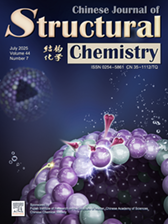
Neodymium-doped hollow Ir/IrO2 nanospheres with low geometric iridium density enable excellent acidic water oxidation performance
Xiaoqian Wei, Hanyu Gao, Tiantian Wang, Zijian Li, Yanru Geng, Guiping Zheng, Min Gyu Kim, Haeseong Jang*, Xien Liu*, Qing Qin* Submit a Manuscript
Yuqing Zhang, Xiao Song, Yongsheng Liu*, Maochun Hong*
Chin. J. Struct. Chem., 2025, 44(7), 100624. DOI: 10.1016/j.cjsc.2025.100624
July 1, 2025
ABSTRACT
In
summary, innovative optothermal-stimulated persistent luminescence nanoparticles
were developed for advanced tumor theranostics. By harnessing photothermal
stimulation, the OSPLIT nanoparticles achieved significantly amplified
brightness and prolonged signal duration, enabling high-contrast imaging of
lymph node metastases with enhanced diagnostic precision. Furthermore, their
photothermal effect facilitated targeted ablation of metastatic tumors,
demonstrating dual functionality in both monitoring and treatment. Collectively,
these results underscore the transformative potential of optothermal
stimulation in enhancing persistent luminescence technologies for precision
oncology applications. Despite significant advancements, further improvements
are essential for practical deployment: (1) a deeper understanding of the
underlying mechanism is needed, particularly regarding how optothermal
stimulation influences charge carrier dynamics in deep traps, as revealed by
theoretical modeling or spectroscopic studies; (2) although the experimental
group exhibited enhanced therapeutic efficacy over control groups, the laser
power required for OSPLIT nanoparticles (0.8 W cm⁻² at 808 nm) exceeds the
American National Standard Institute (ANSI) maximum permissible exposure (0.33
W cm⁻²) [7], underscoring the need for improved photothermal
efficiency to lower the necessary irradiance; (3) to achieve good imaging
results, it is necessary to heat to a certain temperature, which may also
damage normal cells. Future efforts should prioritize the development of
lanthanide-based optothermal-stimulated persistent luminescence systems through
structural engineering to accelerate the translation of next-generation
persistent luminescence technologies into clinical practice.






